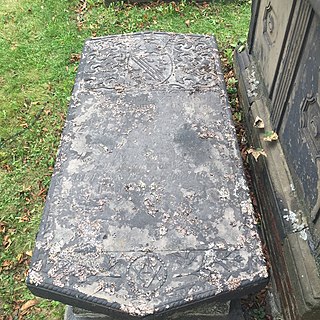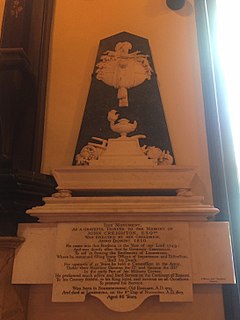
Liverpool is a Canadian community and former town located along the Atlantic Ocean of the Province of Nova Scotia's South Shore. It is situated within the Region of Queens Municipality which is the local governmental unit that comprises all of Queens County, Nova Scotia.
Thomas Head Raddall, OC, FRSC was a Canadian writer of history and historical fiction.

Colonel Simeon Perkins was a Nova Scotia militia leader, merchant, diarist and politician. Perkins led the defence of Liverpool from attacks during the American Revolution, French Revolutionary Wars and the Napoleonic Wars. In the 1770s, Liverpool was the second-largest settlement in Nova Scotia, next to Halifax. He also funded privateer ships in defence of the colony. He wrote a diary for 46 years (1766–1812), which is an essential historic document of this time period in Nova Scotian history. His home is now the Perkins House Museum.

Winckworth Tonge was a soldier, land owner and political figure in Nova Scotia. He represented Cumberland County from 1759 to 1760, King's County from 1765 to 1783 and Hants County from 1785 to 1792 in the Nova Scotia House of Assembly.
William Frederick McCoy, was an Irish-born lawyer and political figure in Nova Scotia, Canada. He represented Shelburne County in the Nova Scotia House of Assembly from 1882 to 1890 as a Liberal member.
Benjamin Belcher was a merchant, militia leader and political figure in Nova Scotia. He was victorious in the Battle off Cape Split during the American Revolution. He represented the township Cornwallis from 1785 to 1793 and King's County from 1793 to 1799 in the Nova Scotia House of Assembly. He also owned slaves.

John Creighton was one of the founding fathers of Lunenburg, Nova Scotia. He led the settlement through the turbulent times of Father Le Loutre's War, the French and Indian War and the American Revolution. He represented Lunenburg County in the Nova Scotia House of Assembly from 1770 to 1775. After establishing the town, he lived the rest of his life in the village until he died fifty-four years later.

The Raid on Lunenburg occurred during the American Revolution when the US privateer, Captain Noah Stoddard of Fairhaven, Massachusetts, and four other privateer vessels attacked the British settlement at Lunenburg, Nova Scotia on 1 July 1782. The raid was the last major privateer attack on a Nova Scotia community during the war.

Nova Scotia is a Canadian province located in Canada's Maritimes. The region was initially occupied by Mi'kmaq. During the first 150 years of European settlement, the colony was primarily made up of Catholic Acadians, Maliseet and Mi'kmaq. During the latter seventy-five years of this time period, there were six colonial wars that took place in Nova Scotia. After agreeing to several peace treaties, this long period of warfare ended with the Burial of the Hatchet Ceremony between the British and the Mi'kmaq (1761) and two years later when the British defeated the French in North America (1763). During these wars, Acadians, Mi'kmaq and Maliseet from the region fought to protect the border of Acadia from New England. They fought the war on two fronts: the southern border of Acadia, which New France defined as the Kennebec River in southern Maine. The other front was in Nova Scotia and involved preventing New Englanders from taking the capital of Acadia, Port Royal, establishing themselves at Canso.

The King's Orange Rangers, also known as the Corps of King's Orange Rangers, were a British Loyalist battalion, raised in 1776 to defend British interests in Orange County, Province of New York and generally in and around the New York colony, although they saw most of their service in the Province of Nova Scotia, British Canada. The battalion's commander was Lieutenant Colonel John Bayard. The Rangers had an undistinguished military record, through most of its existence, and saw very limited combat, mostly against Patriot privateers, but did play an important role in the defense of the colony of Nova Scotia in the later years of the American Revolution. The King's Orange Rangers are especially remembered for their role in the defense of Liverpool, in the Nova Scotia colony.

The Battle off Cape Spilt took place on 21 May 1781 during the American Revolutionary War. The naval battle involved three armed American privateer vessels against three Nova Scotian vessels off Cape Split, Nova Scotia. A Nova Scotia vessel was captured by the American Privateers. Then Capt Bishop tried a rescue operation but was also captured by the American Privateers. Finally, a third vessel under the command of Captain Belcher was able to capture the American Privateer and the first vessel they had taken. Captain Bishop and crew, who had made the failed rescue attempt, were able to take back their ship and imprison their captors.
The Raid on Annapolis Royal took place on 29 August 1781 during the American Revolutionary War. The raid involved two American privateers attacking and pillaging Annapolis Royal, Nova Scotia to revenge the British destruction of the Penobscot Expedition. One historian described it as "one of the most daring and dramatic raids upon Nova Scotia."
The Raid on Charlottetown took place on 17-18 November 1775 during the American Revolutionary War. The raid involved two American privateers of George Washington's Fleet attacking and pillaging Charlottetown.

The Battle off Liverpool took place on 24 April 1778 during the American Revolutionary War. The raid involved the British vessel HMS Blonde and the French vessel Duc de Choiseul.

The Raid on St. John took place on 27 August 1775 during the American Revolutionary War. The raid involved American privateers from Machias, Maine attacking St. John, Nova Scotia. The privateers intended to stop the export of supplies being sent to the loyalists in Boston. This raid was the first hostile act committed against Nova Scotia and it resulted in raising the militia across the colony.
The Raid on Yarmouth took place on 1 December 1775 during the American Revolutionary War. The raid involved American Privateers from Machias, Maine attacking Yarmouth, Nova Scotia. The privateers intended to stop the export of supplies being sent from Nova Scotia to the loyalists in Boston.

Nova Scotia was heavily involved in the American Revolution. The American Revolution (1776–1783) had a significant impact on shaping Nova Scotia. At the beginning, there was ambivalence in Nova Scotia, "the 14th American Colony" as some called it, over whether the colony should join the Americans in the war against Britain. Largely as a result of American Privateer attacks on Nova Scotia villages, as the war continued, the population of Nova Scotia solidified their support for the British. Nova Scotians were also influenced to remain loyal to Britain by the presence of British military units, judicial prosecution of the Nova Scotia Governors and the efforts of Reverend Henry Alline.
The Battle off Halifax took place on 10 July 1780 during the American Revolutionary War. The British Brig HMS Resolution fought the American USS Viper and heavy casualties happened on both sides. The battle was "one of the bloodiest battles in the history of privateering.... a loss of 51 lives in a single battle was virtually unheard of."
Peter Etter (1715-1794) was a loyalist who was a long-term friend of both Benjamin Franklin and future President John Adams. His friendship with Adams broke over Adams decision to support the American Patriots in the American Rebellion. Etter's son Peter Jr. fought with Joseph Gorham against the Eddy Rebellion; another son was Benjamin Etter who became a sliversmith.

The American frigate USS Hancock was captured by the British Royal Navy in a 1777 naval battle during the American Revolutionary War. The two highest ranking naval officers of the war battled each other off the coast of Nova Scotia. HMS Rainbow, under the command of British Admiral George Collier, captured USS Hancock, under the command of Captain John Manley.












